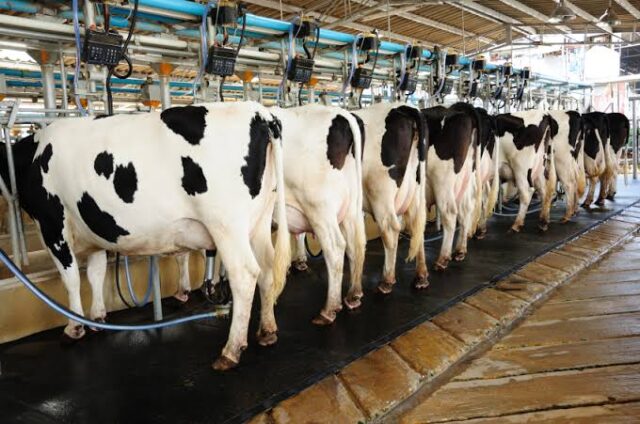
Importance of Biosecurity in Dairy Farming
Biosecurity has emerged as a cornerstone of modern dairy farming. It encompasses measures designed to protect livestock from infectious diseases, pests, and other biological threats. As dairy farming continues to evolve to meet growing global demand for milk and milk products, ensuring the health and productivity of dairy cattle has become increasingly critical. In this article we delve into the concept of biosecurity, its significance, practical strategies for implementation, and its broader implications for the dairy industry.
Understanding Biosecurity
Biosecurity refers to preventive measures aimed at reducing the risk of transmission of infectious agents within and between farms. These measures can include protocols for farm management, animal movement, sanitation, and disease surveillance. In dairy farming, where animals live in close proximity and are susceptible to various diseases, biosecurity practices are essential for maintaining herd health and ensuring economic viability.
Why Biosecurity Matters in Dairy Farming
- Disease Prevention and Control Dairy cattle are vulnerable to a wide array of diseases, such as bovine tuberculosis, mastitis, foot-and-mouth disease, and Johne’s disease. These diseases not only threaten animal health but also reduce milk production, increase veterinary costs, and sometimes lead to culling. Effective biosecurity measures help prevent the introduction and spread of these diseases, ensuring the sustainability of the farming operation.
- Economic Benefits Disease outbreaks can lead to significant financial losses. Beyond the direct costs of treatment and culling, farmers may face losses due to reduced milk yields, market restrictions, and diminished animal value. Preventative biosecurity practices are often far less expensive than managing disease outbreaks, making them a cost-effective approach to farm management.
- Food Safety Healthy cows produce safe milk. Diseases such as mastitis can compromise milk quality, leading to contamination with harmful bacteria like Escherichia coli and Listeria. By maintaining robust biosecurity protocols, farmers can ensure the production of high-quality milk, enhancing consumer confidence and meeting regulatory standards.
- Public Health Several cattle diseases, such as brucellosis and leptospirosis, are zoonotic, meaning they can be transmitted to humans. Biosecurity measures minimize these risks, protecting farm workers and the wider community.
- Environmental Impact Disease outbreaks often result in increased use of antibiotics and other treatments, which can lead to environmental contamination and the development of antimicrobial resistance (AMR). Proactive biosecurity reduces the need for such interventions, promoting more sustainable farming practices.
Key Components of Biosecurity in Dairy Farming
Effective biosecurity involves a multi-faceted approach tailored to the specific needs of the farm. Below are the primary components:
Farm Perimeter and Access Control
- Establishing a secure perimeter with fences and gates helps prevent unauthorized entry of animals, vehicles, and people, reducing the risk of disease introduction.
- Controlled access points, visitor logs, and clear biosecurity signage further enhance farm security.
Animal Health Management
- Quarantine: New or returning animals should be isolated for a minimum period to monitor for signs of disease before integration with the main herd.
- Vaccination: Implementing a comprehensive vaccination program helps protect against common diseases.
- Routine Health Checks: Regular veterinary inspections ensure early detection and management of potential health issues.
Sanitation and Hygiene
- Proper cleaning and disinfection of equipment, vehicles, and facilities are critical to minimizing the risk of pathogen spread.
- Regular cleaning of milking equipment and storage tanks ensures milk safety and prevents contamination.
Feed and Water Safety
- Contaminated feed and water are common sources of disease. Farmers should source feed from reliable suppliers and ensure water is clean and free from pathogens.
- Proper storage of feed to prevent contamination by pests or mold is equally important.
Pest and Wildlife Control
- Rodents, birds, and other wildlife can carry diseases and contaminate feed and water sources. Implementing control measures, such as traps, barriers, and deterrents, is essential.
Employee Training and Awareness
- Workers play a pivotal role in maintaining biosecurity. Regular training ensures they understand and adhere to biosecurity protocols.
- Educating employees about the signs of disease enables early identification and prompt action.
Disease Monitoring and Record-Keeping
- Maintaining detailed records of animal health, vaccination, and treatment histories is crucial for monitoring herd health and identifying trends.
- Implementing systems for disease reporting ensures swift response to potential outbreaks.
Challenges in Implementing Biosecurity
Despite its importance, biosecurity implementation can face several challenges:
- Cost Constraints Many biosecurity measures require financial investment in infrastructure, training, and equipment. Small-scale farmers, in particular, may struggle to afford these expenses.
- Lack of Awareness Not all farmers are fully aware of the importance of biosecurity or the best practices for their farms, leading to inconsistent implementation.
- Compliance and Enforcement Even with established protocols, ensuring consistent adherence by workers and visitors can be difficult. Effective enforcement mechanisms and regular audits are needed.
- Wildlife Interactions Completely preventing contact with wildlife or external animals may be impractical, especially in regions with abundant wildlife populations.
- Antimicrobial Resistance Overreliance on antibiotics as a fallback for disease outbreaks can lead to AMR, highlighting the need for preventative measures and judicious use of medications.
Practical Steps to Improve Biosecurity
- Develop a Biosecurity Plan Every farm should have a tailored biosecurity plan based on its specific risks and needs. The plan should be developed in consultation with veterinarians and other agricultural experts.
- Foster a Culture of Biosecurity Encourage everyone on the farm, from workers to visitors, to take biosecurity seriously. Clear communication and leading by example are key.
- Invest in Infrastructure Upgrades such as dedicated quarantine facilities, proper fencing, and effective waste management systems can significantly enhance biosecurity.
- Collaborate with Neighbors Diseases can spread between farms, especially in regions with dense farming operations. Collaborative efforts, such as synchronized vaccination programs and information sharing, can benefit the entire community.
- Leverage Technology Modern technologies, such as electronic health records, GPS tracking of livestock, and automated cleaning systems, can streamline biosecurity practices and improve efficiency.
The Role of Policy and Regulation
Governments and industry bodies play a vital role in promoting biosecurity. Policies and regulations ensure that farms adhere to minimum standards, while support programs can help farmers implement necessary measures. For example:
- Subsidies or grants can alleviate the financial burden of biosecurity investments.
- Training programs can raise awareness and build capacity among farmers.
- Disease surveillance systems enable early detection and containment of outbreaks.
Future Directions in Dairy Biosecurity
As the dairy industry evolves, biosecurity will continue to adapt to new challenges and opportunities. Key trends include:
- Sustainable Practices Integrating biosecurity with sustainability efforts, such as reducing antibiotic use and minimizing waste, will become increasingly important.
- Data-Driven Decisions The use of big data and artificial intelligence in monitoring animal health and predicting disease outbreaks can revolutionize biosecurity.
- Global Collaboration In an interconnected world, diseases can cross borders quickly. International cooperation on biosecurity standards and research will be crucial.
Conclusion
Biosecurity is more than a set of protocols; it is a commitment to safeguarding animal health, farm profitability, and public well-being. In the face of increasing disease threats and environmental challenges, robust biosecurity measures are indispensable for the future of dairy farming. By prioritizing prevention, fostering awareness, and investing in innovation, the dairy industry can build a resilient and sustainable foundation for generations to come.

















